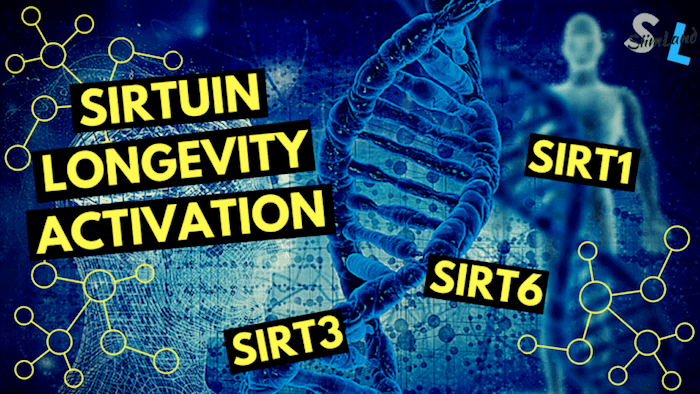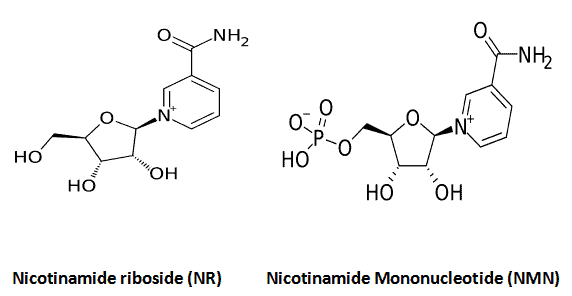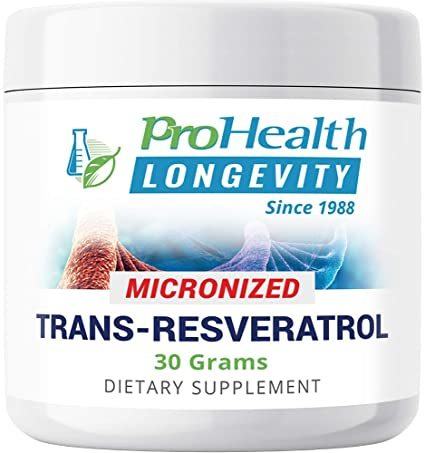Dr. David Sinclair and Rhonda Patrick: How NAD and Trans-Resveratrol Activate Your Longevity Genes
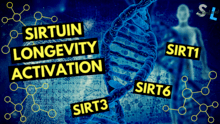
Dr. David Sinclair and Dr. Rhonda Patrick say you can influence how well you age, and possible even extend your lifespan, by adopting certain protocols to activate sirtuins, your longevity genes. Here’s the science and how to do it.
Update (9/20/21): There's some controversy about the benefits of resveratrol. If you currently use resveratrol, or are considering it, make sure you read my update.
There’s a handful of so-called anti-aging scientists who are actively reaching out to the rest of us about the cutting-edge research that’s being done that examines how we might increase our healthspan; even our lifespan. Two of them are Dr. David Sinclair and Dr. Rhonda Patrick. If you want a blueprint on how to, as I like to say, live long and strong, set aside an hour and twelve minutes and listen to the interview in the video below.
If you’re in a hurry, or could use some interpretation and background on the science presented in video, scroll down and wade into the waters, or choose the topic of interest from the table of contents.
What's in this post:
- Who Is Dr. David Sinclair?
- Who Is Dr. Rhonda Patrick?
- An Introduction To Sirtuins and NAD
- How NAD Is Linked To Sirtuins, Resveratrol
- Why The Immune System Exhausts NAD
- The Salvage Pathway Of NAD
- Where Dr. David Sinclair Gets It Wrong About NMN
- Xenohormesis Creates Resveratrol
- Why The Best Resveratrol Supplement Is Trans-Resveratrol
- Why The Best Trans-Resveratrol Supplement Contains BioPerine®
Who Is Dr. David Sinclair?
David A. Sinclair, PhD, is a professor in the Department of Genetics at Harvard Medical School and co-director of the Paul F. Glenn Center for the Biological Mechanisms of Aging. He is the co-founder of the journal Aging, where he serves as co-chief editor, and author of the book Lifespan: Why We Age – and Why We Don’t Have To.
The reason you may want to pay attention to his work is that it focuses on understanding the mechanisms that drive human aging and identifying ways to slow or reverse aging’s effects. As you’ll soon learn, he’s examined the role of sirtuins in disease and aging, with special emphasis on how sirtuin activity is modulated by compounds produced by the body as well as those consumed in the diet, such as resveratrol; particularly, trans-resveratrol, a much more absorbable form. His work has implications for human metabolism, mitochondrial and neurological health, and cancer.
Below, you will see David Sinclair “voice” in the pale yellow boxes; these are quotes taken direclty from the video where he’s interviewed by Dr. Rhonda Patrick.
Dr. David Sinclair obtained his doctoral degree in molecular genetics at the University of New South Wales, Sydney, in 1995. Since then, he has been the recipient of more than 25 prestigious honors and awards and in 2014 was named as one of TIME Magazine’s 100 most influential people in the world. Dr. Sinclair recently authored the book Lifespan: Why We Age – and Why We Don’t Have To.
Aging – a process that began the moment we were born – is generally thought of as inevitable. Although aging isn’t a disease, it is the primary risk factor for developing many chronic diseases, including cardiovascular disease, Alzheimer’s disease, and cancer. In turn, many of these conditions hasten the aging process, setting up a vicious cycle of cellular damage and systemic loss of function. A growing field of research, led by a few innovative scientists proposing radical, contrarian ideas, suggests that aging might not be as inevitable as once thought.
Who Is Dr. Rhonda Patrick?
Formerly a research scientists, Rhonda Patrick, PhD, is an evangelist and educator on topics including the role micronutrient deficiencies play in diseases of aging, the role of genetics in determining the effects of nutrients on a person’s health status, benefits of exposing the body to hormetic stressors, such as through exercise, fasting, sauna use or heat stress, or various forms of cold exposure, and the importance of mindfulness, stress reduction, and sleep.
She did her graduate research at St. Jude Children’s Research Hospital where she investigated the link between mitochondrial metabolism, apoptosis, and cancer. Her groundbreaking work discovered that a protein that is critical for cell survival has two distinct mitochondrial localizations with disparate functions, linking it’s anti-apoptotic role to a previously unrecognized role in mitochondrial respiration and maintenance of mitochondrial structure. Her dissertation findings were published in the 2012 issue of Nature Cell Biology.
An Introduction To Sirtuins and NAD
In the video above, Dr. David Sinclair begins talking about his history with sirtuins at 5:26:
At the time, two scientists doing ground breaking work with sirtuins were Matt Kaeberlein and David Sinclair’s mentor and post doc advisor, Leonard Guarantee. Kaeberlein discovered that by putting in a second copy of SIR2 (Sirtuin 2) into yeast, they lived 3o% longer. Later both Guarantee’s and Sinclair’s labs determined that this happened through a process of mimicking caloric restriction.
Sinclair’s reference to “calorie restriction” refers to a reduction of caloric intake of 30% of normal, which typically is a miserable experience for humans. Happily, studies indicate that these sirtuin longevity genes are activated by intermittent fasting [1, 2], which is easier to do for most people, because the calorie deprivation isn’t a permanent dietary reduction.
Calorie restriction/intermittent fasting plays an important role in activating the sirtuin pathway and also deactivating things like the insulin signaling pathway and IGF-1 pathway. Sirtuins are regulated by NAD, nicotinamide adenine dinucleotide, a coenzyme essential for life given its role in helping the mitochondria in our cells create energy. Without NAD we’d be dead in 30 seconds, says Sinclair. Unfortunately, our body’s production of it declines as we age. A 50 year old has about 50% of NAD as he or she had in their twenties, and an 80 year old as between one and 10% [3].
During the day, your NAD levels will naturally rise, but once you eat a big meal, they’ll go down again. Part of what, then, is affecting NAD are circadian rhythms and food (calories). Incidentally:
NAD is one of the most important molecules in our body, along with ATP (Adenosine triphosphate) and amino acids. They can sense how the environment affects our nutritional uptake, or the lack thereof (abundance vs scarcity), and constitute the three main cellular pathways associated with nutrient sensing; namely:
- Sirtuins, protein enzymes referred to as “longevity genes”;
- AMP kinase, an enzyme that plays a role in cellular energy homeostasis, largely to activate glucose and fatty acid uptake and oxidation when cellular energy is low; and
- mTOR, the mammalian target of rapamycin signaling pathway serves as a central regulator of cell metabolism, growth, proliferation and survival.
“To tweak them”, Dr. David Sinclair is referring to the ability of caloric restriction to increase NAD levels and thereby activate sirtuins, to upregulate AMP Kinase and to inhibit mTOR — all benefical to healthy aging and potentially increasing lifespan [4,5,6].
How NAD Is Linked To Sirtuins, Resveratrol
Sirtuins are enzymes. Dr. Sinclair has a novel way of describing an enzyme:
That car analogy is interesting, because it fits nicely with what happens when the polyphenol resveratrol enters the picture:
Why The Immune System Exhausts NAD
You don’t have to read much about the aging process before you run into what many scientists believe is either an instigator of the pathologies associated with old age, or its cause — chronic inflammation.
As chronic inflammation increases in the body, as it inevitably does for most of us as we get older, our immune system needs to be activated and sustained. As Dr. Rhonda Patrick points out in the interview, this puts an additional burden on NAD, which is required for cells that have a high energy demand, such as activated immune cells, as they require a lot of ATP to function.
So, it appears that at least two things are happening to our poor NAD as we age:
- We’re making less of it; and
- We’re using more of it.
Not only is the immune system a big drain on NAD, so is DNA repair with the activation of PARPs.
Let me explain.
Our DNA (deoxyribonucleic acid) is a molecule composed of two chains that coil around each other to form a double helix carrying genetic instructions for the development, functioning, growth and reproduction of all known organisms and many viruses. DNA is essential for all known forms of life.
A genome is an organism’s complete set of DNA, including all of its genes. Each genome contains all of the information needed to build and maintain an organism, such as you.
As Dr. Patrick describes it, a critical characteristic of aging is genomic instability. This instability comes from many alterations that occur in DNA and irreversibly change the information carried in the genome.
Sirtuins are among the first responders to the site of DNA damage within a cell, where they direct gene expression to begin DNA repair. But as DNA damage accumulates over time, sirtuins become distracted by all the work they have to do on DNA repair to properly regulate gene activity, resulting in a breakdown in sirtuin’s other job, which is to assist cells to properly regulate which genes are switched on and off during the aging process.
Now we get to “PARPS”.
Accompanying the sirtuins’ response is the activation of another class of enzymes, the poly-ADP-ribose-polymerases, or PARPs, a family of DNA repair enzymes that repair single-stranded breaks in DNA by using NAD as a substrate. (A substrate is the starting material of a chemical reaction upon which an enzyme acts on.)
PARP activation depletes cellular levels of NAD (the coenzyme that participates in the production of cellular energy), resulting in a kind of “double hit” that accompanies aging by potentially reducing other important NAD processes, like those required for healthy mitochondrial function required to energize our life.
The Salvage Pathway Of NAD
I keep mentioning NAD and its importance to keep sirtuins activated, so let’s get into how you could boost your NAD levels.
Neohacker Collective has a good explanation summary of the salvage pathway of NAD that I’ll summarize. The salvage pathway is used to produce NAD from nicotinamide molecules from three sources:
- Vitamin B3 (as niacinamide);
- Newer nicotinamides — NR (nicotinamide riboside) and NMN (nicotinamide mononucleotide); and
- Molecules in food that get broken down during digestion into nicotinamide, after which the salvage pathway turns them into NAD in our tissues.
No matter which of these ways is used to make NAD the first time, the salvage pathway is the way we remake NAD after it gets used for cell signaling purposes (i.e., NAD consumption uses).
This NAD salvage pathway starts with nicotinamide, which is vitamin B3, a form of niacin. But you need more than nicotinamide to make NAD in the body, and you can’t simply ingest NAD to increase its levels, because the NAD molecule is too big to enter cells.
So, what do you do to increase increase your NAD levels?
- Exercise
- Restrict calories
- Take NAD precursors
Two widely studied NAD precursors are NR (nicotinamide riboside) and NMN (nicotinamide mononucleotide). Dr. Sinclair has extensively studied NMN; his mentor and PhD advisor Dr. Leonard Guarantee has mainly focused on NR, and created a company to sell a supplement based on NR, called Basis.
Click here to watch Dr. Shin-Ichiro Imai describe the NMN Transporter
Read more about this here.
NR has a different story than NMN. NR is just a smaller version of NMN without a phosphate on it.
When you ingest NR, your body has to first add phosphorus to it and then it has to basically link two of them together to make the NAD; thus NR gets converted into NMN first and then into NAD.
Where Dr. David Sinclair Gets It Wrong About NMN
Don’t get me wrong, I admire the man and his achievements, but toward the end of his interview with Dr. Rhonda Patrick (see 57:51) he makes one statement that is basically wrong, or how I’d rather put it, no longer true: NMN and NR shelf life is unstable so you must refrigerate it to maintain its potency.
I can’t speak to NR, such as Basis, sold by Dr. Guarantee’s company, Elysium Health, but I can weigh in on pure forms of NMN, such as that sold by ProHealth, a company I advise. ProHealth regularly lab tests its NMN for purity and contamination, and the lab reports, such as the one below, show that their NMN is shelf stable without refrigeration for at least three months. If you don’t intend to use it within a three month time frame, refrigerate it, as Sinclair suggests.
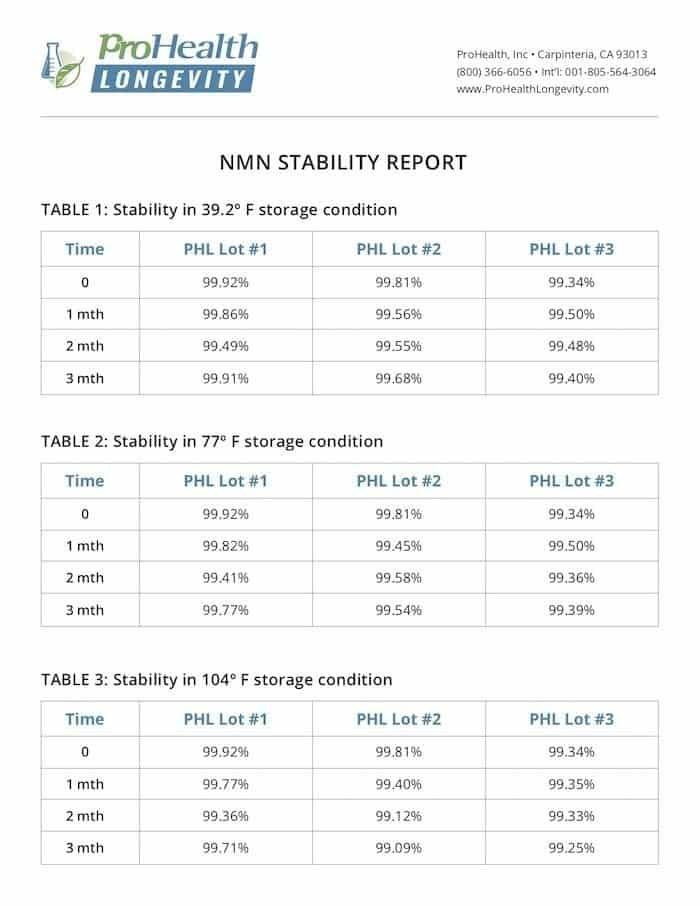 For more on this read, Is Your NMN Supplement Safe and Does Its Potency Last?
For more on this read, Is Your NMN Supplement Safe and Does Its Potency Last?
You can find ProHealth’s basket of NMN products on Amazon.com. I use their NMN Powder.
Xenohormesis Creates Resveratrol
Sirtuin pathways exist in plants as well as humans and other animals, and they get turned on in response to stress. This is referred to as “xenohormesis”, a hypothesis that posits that certain molecules such as plant polyphenols, which indicate stress in the plants, can have a longevity-conferring effect in consumers of plants.
The idea that when we eat stressed plants, we get those molecules and they help activate various cellular pathways associated with longevity. Turns out that resveratrol — found in concentrated in the skin and seeds of various plants, such as red grapes — is a molecule that is produced when those plants get stressed.
So, if resveratrol is so good, does Dr. Sinclair supplement with it?
But there’s two problems with resveratrol supplementation, which is why I will introduce trans-resveratrol to you in a bit, and caution that it be stored in a cool, dark place:
Resveratrol is a potent sirtuin-activating compound (STAC). As mentioned, through xenohormesis It protects the plants in which its found from environmental stressors and disease. When ingested by humans, resveratrol binds to sirtuins, altering their affinity for NAD and their protein substrates, thereby increasing sirtuins’ activity. As such, resveratrol — or I should say, trans-resveratrol — offers a promising therapeutic strategy to ameliorate age-related diseases and extend healthspan.
Let’s dig into those health benefits potentially conferred by resveratrol, particularly trans-resveratrol.
Why The Best Resveratrol Supplement Is Trans-Resveratrol
Dr. David Sinclair isn’t the only person whose seen trans-resveratrol influence better health outcomes than regular resveratrol, typically a form called “cis-resveratrol”. Many studies actually use trans-resveratrol because it’s more effective.
Numerious studies have demonstrated the superiority of trans-resveratrol over other types of resveratrol, such as cis-resveratrol:
- Trans-resveratrol may help promote lifespan extending effects and alleviate metabolic diseases through its activation of sirtuins, the so-called “longevity genes” [7].
- Trans-resveratrol inhibit memory loss and mood dysfunction which can occur during aging [8].
- Trans-resveratrol has superior chemotherapeutic activity than resveratrol [9,10,11].
- Trans-resveratrol is more cardioprotective than resveratrol [12,13,14,15].
- Trans-resveratrol exhibits more Hepatitis C virus inhibition than resveratrol [16].
- Trans-resveratrol is more bioavailable than resveratrol [17,18].
This is not to suggest that regular resveratrol has no therapeutic value; it does. Consider this summary from Healthline.com that lists documented evidence of what even regular, low-absorption resveratrol might be able to do:
- May help lower blood pressure by increasing the production of nitric oxide.
- May benefit blood fats in animals. As an antioxidant, they may also decrease LDL cholesterol oxidation.
- Has lengthened lifespan in animal studies, however, it’s unclear if they would have a similar effect in humans.
- Shows promise in protecting brain cells from damage due to its antioxidant and anti-inflammatory effects.
- Has helped mice develop better insulin sensitivity and fight complications of diabetes. In the future, humans with diabetes might also benefit from resveratrol therapy.
- May help relieve joint pain by preventing cartilage from breaking down.
- Has shown exciting cancer-blocking activity in test tubes and animal studies.
Clearly, resveratrol is worth examining, and the best resveratrol supplement you can take is trans-resveratrol. But it can be made even better by adding BioPerine®.
Why The Best Trans-Resveratrol Supplement Contains BioPerine®
BioPerine® is a patented extract obtained from black pepper fruits (Piper nigrum) standardized to contain a minimum of 95% Piperine. It’s used safely and extensively as a bioavailability enhancer for over 20 years [19].
An in vivo study (taking place in a living organism) conducted by the University of Wisconsin showed that BioPerine® significantly improved the bioavailability of Resveratrol by 229% and the maximum serum concentration was increased by 1,544% [20].
Another study examined the effects of resveratrol and piperine supplementation in combination with exercise training on the skeletal muscle mitochondrial capacity of the forearms of sixteen healthy young adults.
The volunteers were given pills containing placebo or resveratrol (500 mg) + BioPerine® (10 mg) combination for four weeks. All participants performed three sessions of sub-maximal endurance training of the wrist flexor muscles of the non-dominant arm every week.
The researchers concluded:
“…low-intensity exercise training can increase forearm skeletal muscle mitochondrial capacity when combined with resveratrol and piperine supplementation.” [21]
Clearly, supplementation with resveratrol and BioPerine® combination improves the bioavailability of resveratrol, and might be helpful in enhancing skeletal muscle mitochondrial capacity during low-intensity exercise training.
ProHealth will soon release its newly formulated 1000 Trans-Resveratrol product, but until then you may want to check out MAAC10 Resveratrol.
Prohealth’s new formulation is now available:
Your Takeaway
You can adopt certain protocols that can influence how well you age; meaning, how healthy your remain as you get older, and potentially even living longer as well.
To do this, focus on activating your sirtuins, the “longevity genes” by doing three things:
- Regularly reduce your caloric consumption via intermittent fasting, or regular fasting (water and tea for a day or more, if you’re healthy enough). Read my articles on intermittent fasting.
- Exercise. Read my six-part series, The Functionally Fast Fit Workout.
- Supplement with trans-resveratrol and either NR or NMN.
Last Updated on February 21, 2022 by Joe Garma

